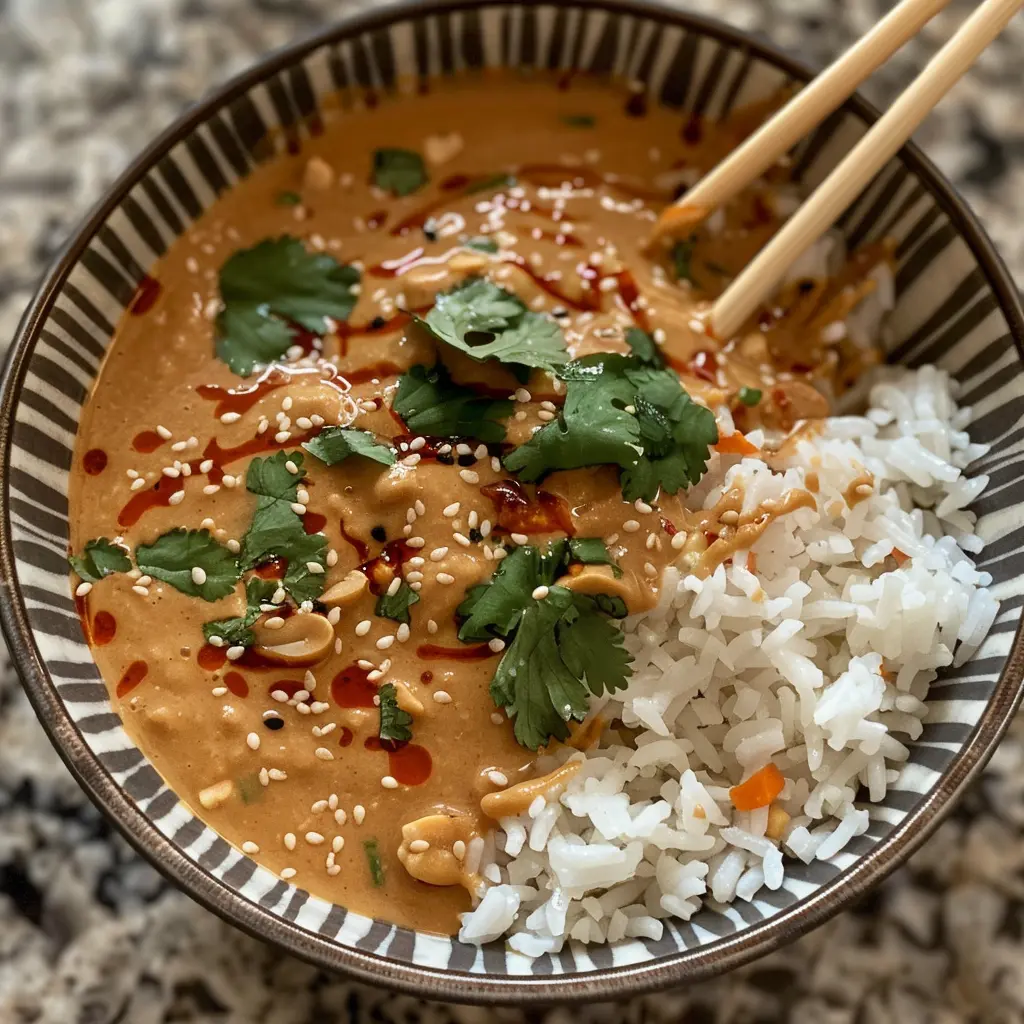Thai Peanut Sauce is one of those rare culinary treasures that transcends cultures, cravings, and even seasons. Whether it’s drizzled over grilled satay, tossed with rice noodles, or used as a dip for fresh vegetables, this creamy, nutty, slightly spicy condiment brings a depth of flavor that’s unmistakably Thai.
But this isn’t just another peanut sauce recipe. This is my grandmother’s version—made with heart, history, and a whole lot of peanuts.
A Taste of Thailand, From My Family to Yours
I still remember the rhythmic sound of her granite mortar and pestle, the soft sizzle of coconut milk warming on the stovetop, and the intoxicating aroma of red curry paste and crushed peanuts mingling in the humid kitchen air. My Thai grandmother’s cooking was legendary in our family. While her green curry and mango sticky rice were standouts, her peanut sauce was everything.
She never measured a thing—only tasted, adjusted, and smiled when it was just right. I’ve taken those same ingredients and refined them into an easy, repeatable version you can make in under 15 minutes in your own kitchen.
What Is Thai Peanut Sauce?
At its core, Thai Peanut Sauce (also known as satay sauce) is a creamy blend of peanuts, coconut milk, and traditional Thai seasonings like red curry paste, tamarind, and fish sauce. What sets Thai peanut sauce apart from American or Indonesian versions is its balance. Thai cuisine is built on harmony: sweet, salty, sour, and spicy—all in one bite.
Why Thai Peanut Sauce Deserves a Spot in Your Kitchen
- 🧠 Nutritious: Packed with protein, healthy fats, and antioxidants.
- ⏱ Quick & Easy: 10–15 minutes, one saucepan, minimal cleanup.
- 🌶 Customizable: Make it mild or fiery, vegan or with fish sauce.
- 🌍 Versatile: Dip, drizzle, marinade—this sauce does it all.
- 🌿 Naturally Gluten-Free & Dairy-Free: Easily adapted for any diet.
Ingredients: Building the Perfect Balance
Here’s everything you need to create the ultimate Thai Peanut Sauce:
- ¾ cup creamy peanut butter (unsweetened is best)
- 1 cup full-fat coconut milk
- 2 tablespoons red curry paste
- 1½ tablespoons brown sugar or palm sugar
- 1 tablespoon tamarind paste (or 1 tbsp lime juice)
- 1 tablespoon soy sauce or tamari
- 1 teaspoon fish sauce (optional for depth; omit for vegan)
- 1 teaspoon rice vinegar
- 1–2 teaspoons chili garlic sauce or Sriracha
- ¼ cup warm water (to thin)
Optional Garnishes:
- Crushed peanuts
- Fresh cilantro
- Lime wedges
How to Make Thai Peanut Sauce (Step-by-Step)
Prep Time: 5 minutes
Cook Time: 5 minutes
Total Time: 10 minutes
Servings: 4–6
1. Warm the Coconut Milk
In a medium saucepan, gently warm the coconut milk over medium heat. Add red curry paste and whisk until fully combined and fragrant—about 2–3 minutes.
2. Add Peanut Butter
Add peanut butter to the warm mixture and stir until smooth and creamy.
3. Season the Sauce
Stir in the sugar, tamarind paste, soy sauce, fish sauce (if using), rice vinegar, and chili garlic sauce. Keep whisking gently to prevent sticking.
4. Adjust Thickness
Add water, a little at a time, until you reach your desired consistency. For dipping, keep it thick. For dressings or marinades, thin it out slightly.
5. Taste and Tweak
Taste your sauce and adjust:
- Need more salt? Add soy sauce.
- Too rich? Add more vinegar or lime juice.
- Want more heat? Increase the chili paste.
How to Store and Reheat
- Fridge: Store in an airtight container for up to 1 week.
- Freezer: Freeze for up to 3 months. Thaw in the fridge and reheat slowly.
- Reheat Tip: Add a splash of water or coconut milk when reheating to refresh the texture.
How to Use Thai Peanut Sauce: Delicious Ideas

Thai Peanut Sauce is more than just a dip—it’s a versatile kitchen hero. Here are my top ways to use it:
🥢 1. Classic Satay Dipping Sauce
Serve warm alongside grilled chicken, beef, or tofu skewers. Don’t forget cucumber salad and sticky rice on the side!
🥗 2. Thai Noodle Salad Dressing
Toss with rice noodles, shredded cabbage, julienned carrots, and herbs like mint and cilantro. Add protein for a full meal.
🥬 3. Spring Roll Companion
Use as a dipping sauce for fresh summer rolls filled with shrimp, avocado, noodles, and herbs.
🥪 4. Sandwich Spread
Upgrade your sandwich game—spread it on wraps or in a Thai-style bánh mì.
🍲 5. Stir-Fry Sauce
Thin with water or broth and pour over sautéed vegetables and noodles or rice.
🥒 6. Buddha Bowl Booster
Drizzle over grain bowls with quinoa, roasted sweet potatoes, chickpeas, and greens.
Make It Your Own: Variations & Substitutions
- No Curry Paste? Use ½ tsp ground cumin + chili flakes.
- Vegan? Skip the fish sauce or use vegan fish sauce alternatives.
- Nut Allergy? Substitute sunflower seed butter or tahini.
- Low-Carb? Use a sugar substitute like monk fruit or stevia.
Nutritional Information (Per Serving)
| Nutrient | Amount |
|---|---|
| Calories | 180 |
| Fat | 14g |
| Carbohydrates | 9g |
| Protein | 5g |
| Sugar | 3g |
| Fiber | 2g |
Note: Values vary based on ingredients and portion size.
Pro Tips for the Perfect Thai Peanut Sauce
- Always Taste Before Serving: Thai cooking is about balance.
- Use High-Quality Coconut Milk: Full-fat, no additives for the creamiest texture.
- Fresh vs. Processed: If you can, grind your own peanuts for richer flavor.
- Double the Batch: This sauce goes fast. You’ll thank yourself later.
Why Thai Peanut Sauce Is So Popular
Thai Peanut Sauce is beloved worldwide because it:
- Offers complexity with simplicity—layers of flavor with simple ingredients
- Balances comfort food richness with zesty freshness
- Works for all diets with easy swaps
- Is universally delicious—who doesn’t love creamy peanut goodness?
Common Questions (FAQ)
Can I make it in advance?
Absolutely! It stores beautifully and even tastes better the next day as the flavors meld.
Is Thai Peanut Sauce spicy?
It has a mild to moderate kick. Adjust the chili to suit your taste.
Is it authentic?
Yes—this version uses traditional Thai ingredients and techniques, adapted for modern kitchens without losing the soul of the dish.
Can I make it sugar-free?
Yes! Use monk fruit or skip sugar entirely if you’re using sweetened coconut milk.
Final Thoughts

Thai Peanut Sauce isn’t just a condiment—it’s a celebration of Thai culinary tradition. With its velvety texture, punchy flavor, and incredible versatility, it’s no wonder this sauce is loved in kitchens across the globe. Whether you’re new to Thai cooking or a lifelong fan, this recipe will become a staple you turn to again and again.
So grab those peanuts, fire up your stove, and bring a little taste of Thailand into your home. Your noodle bowls, grilled meats, and salad rolls will never be the same again.



1 thought on “Authentic Thai Peanut Sauce Recipe: A Creamy, Flavor-Packed Classic”